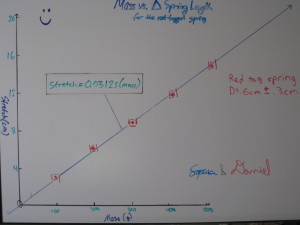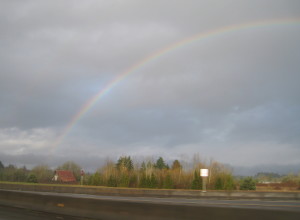EXPERIMENT
How do students discover the concepts and mathematical relationships of physics?
Students will discover the concepts and mathematical relationships of physics throughhands-on exploration and experimentation. Students will:
- observe phenomena and take data

- look for patterns in the data
- develop models based on the data
- share ideas and come to consensus
- design and conduct experiments to test models
- revise models to incorporate new data
- apply validated models to new situations
In this approach, students construct understanding from what they have seen in the lab before they read about it in the text or receive information from me. Names for quantities, such as “acceleration” or “voltage,” are labels the students give to ideas they have already developed through experiments, rather than being words they hear and then try to attach meaning to. Students create equations as a short-hand way to express the relationship they found on their graph rather than first encountering them as a series of abstract symbols they found in the textbook.
PROBLEM SOLVING
How are the concepts and mathematical models used?
A model that has been validated by testing is (tentatively) accepted as a good explanation for how the world works. The next step is to apply the concepts and mathematical relationships of the model to new situations through problem solving. Problem solving requires that students think and reason about which concepts apply in a situation, why they apply, and how to apply them. Conceptual problems involve reasoning based on concepts alone, without mathematics, and quantitative problems go a step further by requiring calculations to arrive at an answer. Students gain deeper and broader understanding of concepts as they apply them in a range of contexts. The thinking skills that are developed through problem-solving in physics benefit students in all aspects of their lives, and are one of the most long-lasting benefits of studying physics.
REAL LIFE APPLICATIONS
Where is physics in my life?
 I want my students to connect the physics they have learned to the world around them. When traveling on a freeway offramp in the rain they might tell you why the curve is banked and what the rain does to the coefficient of friction and the time needed to stop. They could explain why eyeglasses help people see better, how noise-cancellation headphones work, how to make a motor and a loudspeaker, and how rainbows form. They can appreciate that a rope swing is a pendulum, that the pogo stick stores energy in a spring, why the space shuttle doesn’t fall back to earth, how the epicenter of an earthquake is found, and how GPS works.
I want my students to connect the physics they have learned to the world around them. When traveling on a freeway offramp in the rain they might tell you why the curve is banked and what the rain does to the coefficient of friction and the time needed to stop. They could explain why eyeglasses help people see better, how noise-cancellation headphones work, how to make a motor and a loudspeaker, and how rainbows form. They can appreciate that a rope swing is a pendulum, that the pogo stick stores energy in a spring, why the space shuttle doesn’t fall back to earth, how the epicenter of an earthquake is found, and how GPS works.
